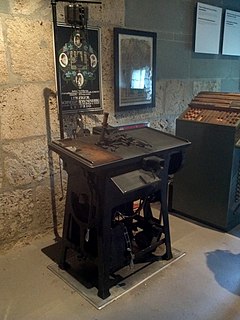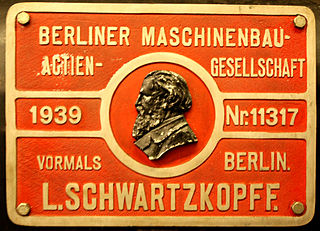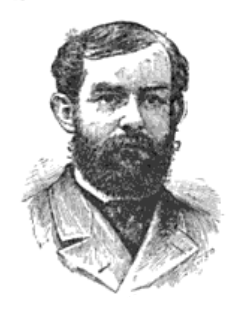The Mergenthaler Linotype Company is a corporation founded in the United States in 1886 to market the Linotype machine, a system to cast metal type in lines (linecaster) invented by Ottmar Mergenthaler. It became the world's leading manufacturer of book and newspaper typesetting equipment; outside North America, its only serious challenger for book production was the Anglo-American Monotype Corporation. It also offered phototypesetting and digital products before being taken over by Monotype Imaging in 2006. Since March 2013, its legal name has been changed to Monotype GmbH.

The Linotype machine was a "line casting" machine used in printing sold by the Mergenthaler Linotype Company and related companies. It was a hot metal typesetting system that cast blocks of metal type for individual uses. Linotype became one of the mainstay methods to set type, especially small-size body text, for newspapers, magazines, and posters from the late 19th century to the 1970s and 1980s, when it was largely replaced by phototypesetting and computer typesetting. The name of the machine comes from the fact that it produces an entire line of metal type at once, hence a line-o'-type, a significant improvement over the previous industry standard, i.e., manual, letter-by-letter typesetting using a composing stick and shallow subdivided trays, called "cases".

Ottmar Mergenthaler was a German-American inventor who has been called a second Gutenberg, as Mergenthaler invented the linotype machine, the first device that could easily and quickly set complete lines of type for use in printing presses. This machine revolutionized the art of printing.
William Addison Dwiggins, was an American type designer, calligrapher, and book designer. He attained prominence as an illustrator and commercial artist, and he brought to the designing of type and books some of the boldness that he displayed in his advertising work. His work can be described as ornamented and geometric, similar to the Art Moderne and Art Deco styles of the period, using Oriental influences and breaking from the more antiquarian styles of his colleagues and mentors Updike, Cleland and Goudy.

Phototypesetting is a method of setting type, rendered obsolete with the popularity of the personal computer and desktop publishing software, that uses a photographic process to generate columns of type on a scroll of photographic paper.

Rudolph Ruzicka was a Czech-born American wood engraver, etcher, illustrator, typeface designer, and book designer. Ruzicka designed typefaces and wood engraving illustrations for Daniel Berkeley Updike's Merrymount Press, and was a designer for, and consultant to, the Mergenthaler Linotype Company for fifty years. He designed a number of seals and medals, including the American Institute of Graphic Arts (AIGA) and the Dartmouth Medal of the American Library Association.

A Ludlow Typograph is a hot metal typesetting system used in letterpress printing. The device casts bars, or slugs of type, out of type metal primarily consisting of lead. These slugs are used for the actual printing, and then are melted down and recycled on the spot. It was used to print large-type material such as newspaper headlines or posters.

Berliner Maschinenbau AG was a German manufacturer of locomotives.

Chauncey H. Griffith (1879–1956) was an American printer and typeface designer.

Caledonia is a serif typeface designed by William Addison Dwiggins in 1938 for the Mergenthaler Linotype Company and commonly used in book design. As a transitional serif design, one inspired by the Scotch Roman typefaces of the early nineteenth century, Caledonia has a contrasting design of alternating thick and thin strokes, a design that stresses the vertical axis and sharp, regular serifs on ascenders and descenders.

Mergenthaler Vocational-Technical High School is a public high school located in Baltimore, Maryland, United States. It is one of the two premiere vocational-technical high schools of the city, the other being rival Carver Vocational-Technical High School, on Presstman Street, on the other side of the city in West Baltimore.
Jackson Burke was an American type and book designer. After studying at the University of California, Berkeley, he succeeded C.H. Griffith as Director of Typographic Development at Mergenthaler Linotype from 1949 until 1963, where he designed several type faces.

James Ogilvie Clephane was an American court reporter and venture capitalist who was involved in improving, promoting and supporting several inventions of his age, including the typewriter, the graphophone, and the linotype machine. He has been called the "father of the linotype machine", and the development of mechanical typesetting was largely due to his initiative.
Walter Valentine Tracy RDI was an English type designer, typographer and writer.

Spartan is a geometric sans-serif typeface created by John L. Renshaw for Mergenthaler Linotype Company as a direct competitor to Bauer's Futura. The face was made for machine composition by Linotype, while identical foundry type was issued by American Type Founders (ATF). Testing by Bausch & Lomb, after the creation of Spartan in 1951, determined it to be the "most readable" typeface of the time.

The Intertype Corporation produced the Intertype, a typecasting machine closely resembling the Linotype, and using the same matrices as the Linotype. It was founded in New York in 1911 by Hermann Ridder, of Ridder Publications, as the International Typesetting Machine Company, but purchased by a syndicate for $1,650,000 in 1916 and reorganized as the Intertype Corporation.

D. Stempel AG was a German typographic foundry founded by David Stempel (1869–1927), in Frankfurt am Main, Germany. Many important font designers worked for the Stempel foundry, including Hans Bohn, Warren Chappell, F. H. Ehmcke, Friedrich Heinrichsen, Hanns Th. Hoyer, F. W. Kleukens, Erich Meyer, Hans Möhring, Hiero Rhode, Wilhelm Schwerdtner, Herbert Thannhaeuser, Martin Wilke, Rudolf Wolf, Victor Hammer, Hermann Zapf, and Gudrun Zapf von Hesse. With the introduction of Memphis in 1929, the foundry was the first to cast modern slab serif typefaces.

The Legibility Group is a series of serif typefaces created by the American Mergenthaler Linotype Company and intended for use in newspapers on Linotype's hot metal typesetting system. They were developed in-house by Linotype's design team, led by Chauncey H. Griffith, and released from 1922, when the first member, Ionic No. 5, appeared.













